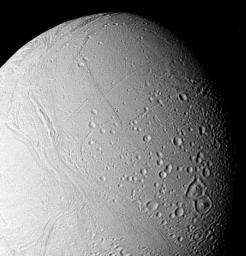
|
Surface of Enceladus
- Click the image above for a larger view
- Full-Res JPEG (450 x 469) (38.9 kB)
- Full-Res TIFF (450 x 469) (178.0 kB)
Caption:
The surface of Enceladus is seen in this closeup view obtained Aug. 25, when Voyager 2 was 112,000 kilometers (69,500 miles) from this satellite of Saturn. This view, in which Enceladus north pole is toward the bottom right, shows the moon to bear a striking resemblance of Ganymede, the largest Galilean satellite of Jupiter. Moderately cratered areas have been transected by strips of younger grooved terrain. This more recently formed terrain--the light cratering says it must be relatively young--has consumed portions of craters such as those near the bottom center of this picture. This suggests that Enceladus has experienced internal melting even though it is only about 490 km. (300 mi.) in diameter. The grooves and linear features indicate that the satellite has been subjected to considerable crustal deformation as a result of this internal melting. The largest crater visible here is about 35 km. (20 mi.) across.
Background Info:
The Voyager Project is managed for NASA by the Jet Propulsion Laboratory, Pasadena, Calif.
Cataloging Keywords:
| Name | Value | Additional Values |
|---|---|---|
| Target | Enceladus | Ganymede, Jupiter, Saturn |
| System | Saturn | Jupiter |
| Target Type | Satellite | Planet |
| Mission | Voyager | |
| Instrument Host | Cassini Orbiter | Voyager 2 |
| Host Type | Orbiter | Flyby Spacecraft |
| Instrument | Imaging Science Subsystem (ISS) | |
| Detector | ||
| Extra Keywords | Crater, Grayscale | |
| Acquisition Date | ||
| Release Date | 1999-04-11 | |
| Date in Caption | ||
| Image Credit | NASA/JPL | |
| Source | photojournal.jpl.nasa.gov/catalog/PIA01950 | |
| Identifier | PIA01950 | |
